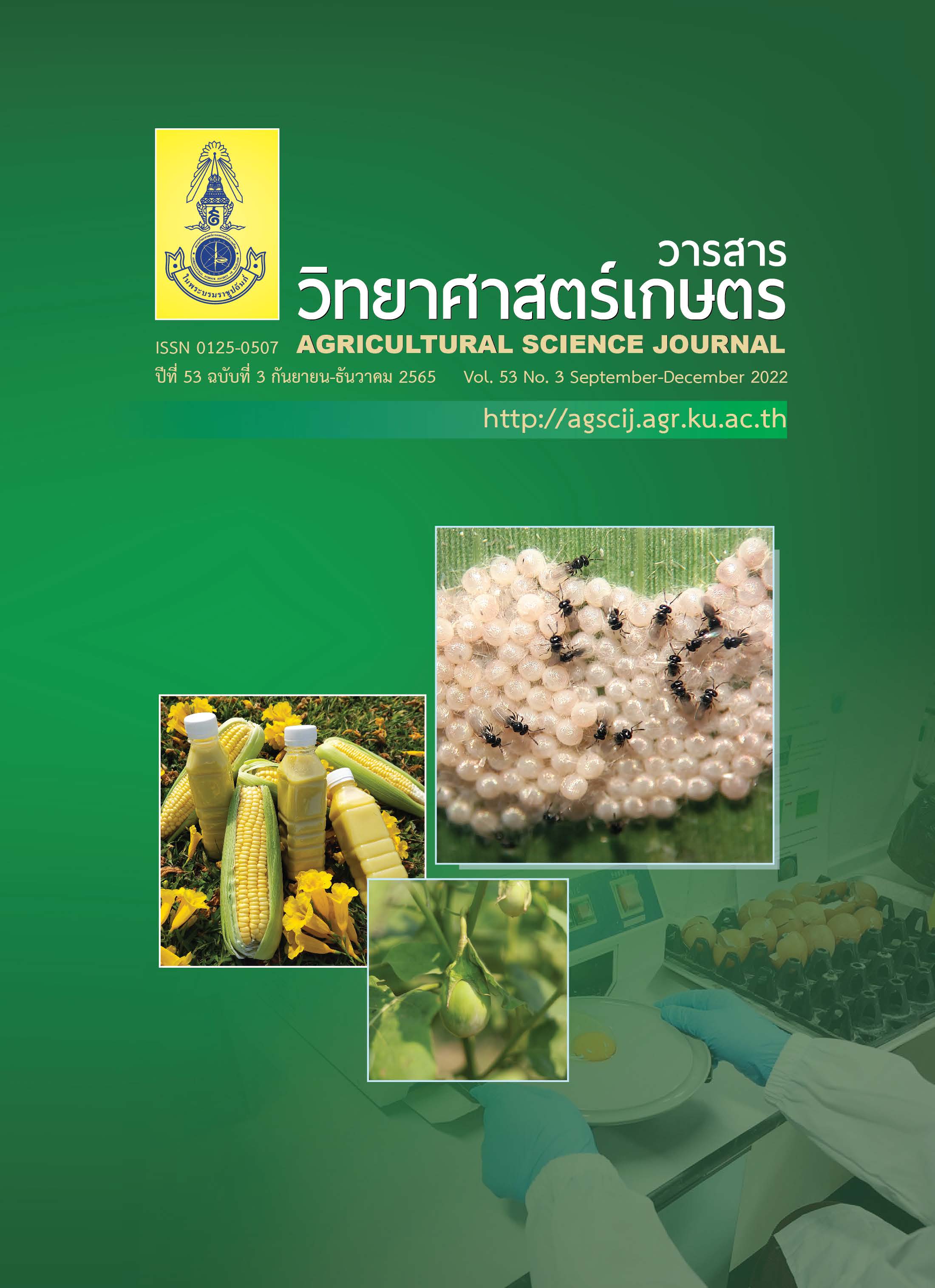เปรียบเทียบผลของการติดเชื้อไวรัส Cymbidium mosaic virus (CymMV) ต่อการเจริญเติบโต ปริมาณและคุณภาพดอกของกล้วยไม้พันธุ์เอียสกุล (BOM)
Main Article Content
บทคัดย่อ
กล้วยไม้สกุลหวายลูกผสมตัดดอกที่ขยายพันธุ์ด้วยวิธีการผ่าลำหรือการเพาะเลี้ยงเนื้อเยื่อ โดยไม่มีการตรวจสอบเชื้อไวรัส Cymbidium mosaic virus (CymMV) พบมีการติดเชื้อไวรัสและแพร่ระบาดในอัตราที่สูง วัตถุประสงค์ของงานวิจัยนี้คือ ศึกษาผลของการติดเชื้อไวรัส CymMV ต่อการเจริญเติบโต ปริมาณดอก และคุณภาพดอกของกล้วยไม้พันธุ์เอียสกุล (BOM) วางแผนการทดลองแบบสุ่มสมบูรณ์ เปรียบเทียบผลระหว่างต้นที่ปลอดเชื้อไวรัส (ชุดควบคุม) และต้นที่ติดเชื้อไวรัส CymMV โดยคัดเลือกหน่อต้นกล้วยไม้ที่ปลอดเชื้อไวรัสและที่ติดเชื้อไวรัส CymMV ด้วยชุดตรวจสอบไวรัสอย่างง่าย POCy kit นำชิ้นส่วนตาของกล้วยไม้ที่ปลอดเชื้อไวรัสและติดเชื้อไวรัส CymMV ชักนำให้เกิด protocorm-like bodies (PLBs) และชักนำให้เป็นยอดจนได้ต้นกล้ากล้วยไม้ออกปลูกเป็นไม้กระถางขนาด 3.5 นิ้ว หลังปลูกที่ 3 และ 6 เดือน พบว่า ความสูงของลำหน้า เส้นผ่าศูนย์กลางของลำหน้า และจำนวนช่อดอกต่อกอของต้นที่ปลอดเชื้อไวรัสมีการเจริญเติบโตดีกว่าต้นที่ติดเชื้อไวรัสในทั้งสองช่วงอายุอย่างมีนัยสำคัญยิ่งทางสถิติ (P < 0.01) ขณะที่ จำนวนลำตอกอของต้นกล้วยไม้ทั้งสองกลุ่มมีความแตกต่างกันที่อายุ 6 เดือน เท่านั้น (P < 0.01) เมื่อปลูกเป็นไม้ตัดดอกโดยใช้กาบมะพร้าวเป็นวัสดุปลูกภายใต้สภาวะโรงเรือนกึ่งปิดควบคุมสภาพแวดล้อมและโรงเรือนที่คลุมสแลน 50 เปอร์เซ็นต์ ไม่ควบคุมสภาพแวดล้อม พบว่า ที่ช่วงอายุ 20 เดือน ความสูงของลำหน้า เส้นผ่าศูนย์กลางของลำหน้า ปริมาณช่อดอกต่อกอ และจำนวนช่อดอกต่อลำของต้นกล้วยไม้ที่ปลอดเชื้อไวรัสมีการเจริญเติบโตที่ดีกว่าต้นที่ติดเชื้อไวรัสในทั้ง 2 โรงเรือน และมีความแตกต่างกันทางสถิติอย่างมีนัยสำคัญยิ่ง (P < 0.01) ขณะที่ จำนวนลำตอกอของต้นที่ปลอดเชื้อไวรัสมีจำนวนมากกว่าต้นที่เชื้อไวรัสเมื่อปลูกในโรงเรือนที่คลุมสแลน 50 เปอร์เซ็นต์ ไม่ควบคุมสภาพแวดล้อมเท่านั้น (P < 0.01) สำหรับคุณภาพช่อดอกและขนาดของดอกกล้วยไม้เมื่ออายุ 9 และ 15 เดือน พบว่า ความยาวช่อดอก จำนวนดอกต่อช่อ และขนาดดอกของต้นที่ปลอดเชื้อไวรัสมีค่ามากกว่าต้นที่ติดเชื้อไวรัสอย่างมีนัยสำคัญทางสถิติ ผลการทดสอบอายุการปักแจกันของช่อดอกกล้วยไม้ในน้ำเปล่าที่อุณหภูมิห้อง พบว่า ช่อดอกกล้วยไม้ของต้นที่ปลอดเชื้อไวรัสมีอายุการปักแจกัน 14 วัน ส่วนช่อดอกของต้นที่ติดเชื้อไวรัส CymMV มีอายุการปักแจกัน 21 วัน เนื่องจากต้นที่ปลอดเชื้อไวรัสมีการคายน้ำสูงกว่าทำให้สูญเสียน้ำและความเต่งมากกว่าส่งผลให้เกิดการเสื่อมสภาพเร็วขึ้น ดังนั้น ควรคัดเลือกต้นพันธุ์ที่ปลอดเชื้อไวรัสมาทำการขยายพันธุ์จะส่งผลให้ได้ผลผลิตเพิ่มขึ้นและมีคุณภาพ
Article Details

อนุญาตภายใต้เงื่อนไข Creative Commons Attribution-NonCommercial-NoDerivatives 4.0 International License.
เอกสารอ้างอิง
Arditti, J. 1992. Fundamentals of Orchid Biology. John Wiley & Sons, Inc., New York, USA. 691 pp.
Bumrung, S., D. Boonchai, A. Mongkolchaiyaphruek and P. Boonkorkaew. 2019. Effects of CymMV– infected on growth, yield and quality of Dendrobium Sonia ‘Earsakul’ under difference greenhouse. Agricultural Sci. J. 50(3): 309–322. (in Thai)
Cardoso, J.C., C.A. Zanello and J.T. Chen. 2020. An overview of orchid protocorm–like bodies: mass propagation, biotechnology, molecular aspects, and breeding. Int. J. Mol. Sci. 21(3): 985.
Chia, T.F. and J. He. 1999. Photosynthetic capacity in Oncidium (Orchidaceae) plants after virus eradication. Environ. Exp. Bot. 42(1): 11–16.
Funayama, S., K. Hikosaka and T. Yahara. 1997. Effects of virus infection and growth irradiance on fitness components and photosynthetic properties of Eupatorium makinoi (Compositae). Am. J. Bot. 84(6): 823–829.
Hew, C.S. and J.W.H. Yong. 2004. The Physiology of Tropical Orchids in Relation to the Industry. 2nd edition. World Scientific Publishing Co., Inc., New Jersey, USA. 370 pp.
Jeong, D.S., K.H. Hong and K.I. Park. 2021. Detection of Cymbidium mosaic virus and Odontoglossum ringspot virus in Phalaenopsis in Korea. Hortic. Sci. Technol. 39(4): 514–520. (in Korean)
Kahohem, N., D. Boonchai, P. Kasemsap and P. Boonkorkaew. 2021. Comparison of greenhouse types and cooling systems on growth and flower quality in Dendrobium ‘Big White Jumbo’. Agricultural Sci. J. 52(1): 90–106. (in Thai)
Khentry, Y., A. Paradornuwat, S. Tantiwiwat, S. Phansiri and N. Thaveechai. 2006. Incidence of Cymbidium mosaic virus and Odontoglossum ringspot virus in Dendrobium spp. in Thailand. Crop Prot. 25(9): 926–932.
Kiratiyaangul, S., W. Srithongchai and S. Saepaisal. 2011. Diseases of orchids caused by viruses and prevent elimination. Academic Papers. Department of Agriculture, Ministry of Agriculture and Cooperatives, Bangkok, Thailand. 12 pp. (in Thai)
Lee, H.B., J.H. Lee, S.K. An, J.H. Park and K.S. Kim. 2019. Growth characteristics and flowering initiation of Phalaenopsis Queen Beer ‘Mantefon’ as affected by the daily light integral. Hortic. Environ. Biotechnol. 60(5): 637–645.
Lee, S.C., H. Pai, Y.W. Huang, M.H. He, Y.L. Song, S.Y. Kuo, W.C. Chang, Y.H. Hsu and N.S. Lin. 2021. Exploring the multifunctional roles of Odontoglossum ringspot virus P126 in facilitating Cymbidium mosaic virus cell–to–cell movement during mixed infection. Viruses (13)8: 1552.
Ochoa-Martínez, D.L., E.A. Pérez-García, M.G. Carrillo-Benítez, E.J. Zamora-Macorra and D. Orozco-Cirilo. 2019. Cymbidium mosaic virus and Odontoglossum ringspot virus in various genera of cultivated orchids in Mexico. Mex. J. Phytopathol. 37(3): 175.
Pradhan, S., T. Regmi, M. Ranjit and B. Pant. 2016. Production of virus-free orchid Cymbidium aloifolium (L.) Sw. by various tissue culture techniques. Heliyon. 2(10): e00176.
Pun, U.K. and K. Ichimura. 2003. Role of sugars in senescence and biosynthesis of ethylene in cut flowers. Jpn. Agric. Res. Q. 37(4): 219–224.
Vacin, E.F. and F.W. Went. 1949. Some pH changes in nutrient solutions. Botanical Gazette 110(4): 605–613.
Yamane, K., K. Oyama, E. Iuchi, H. Ogawa, T. Suzuki and T. Natsuaki. 2008. RT-PCR Detection of Odontoglossum ringspot virus, Cymbidium mosaic virus and Tospoviruses and association of infections with leaf-yellowing symptoms in Phalaenopsis. J. Phytopathol. 156(5): 268–273.


